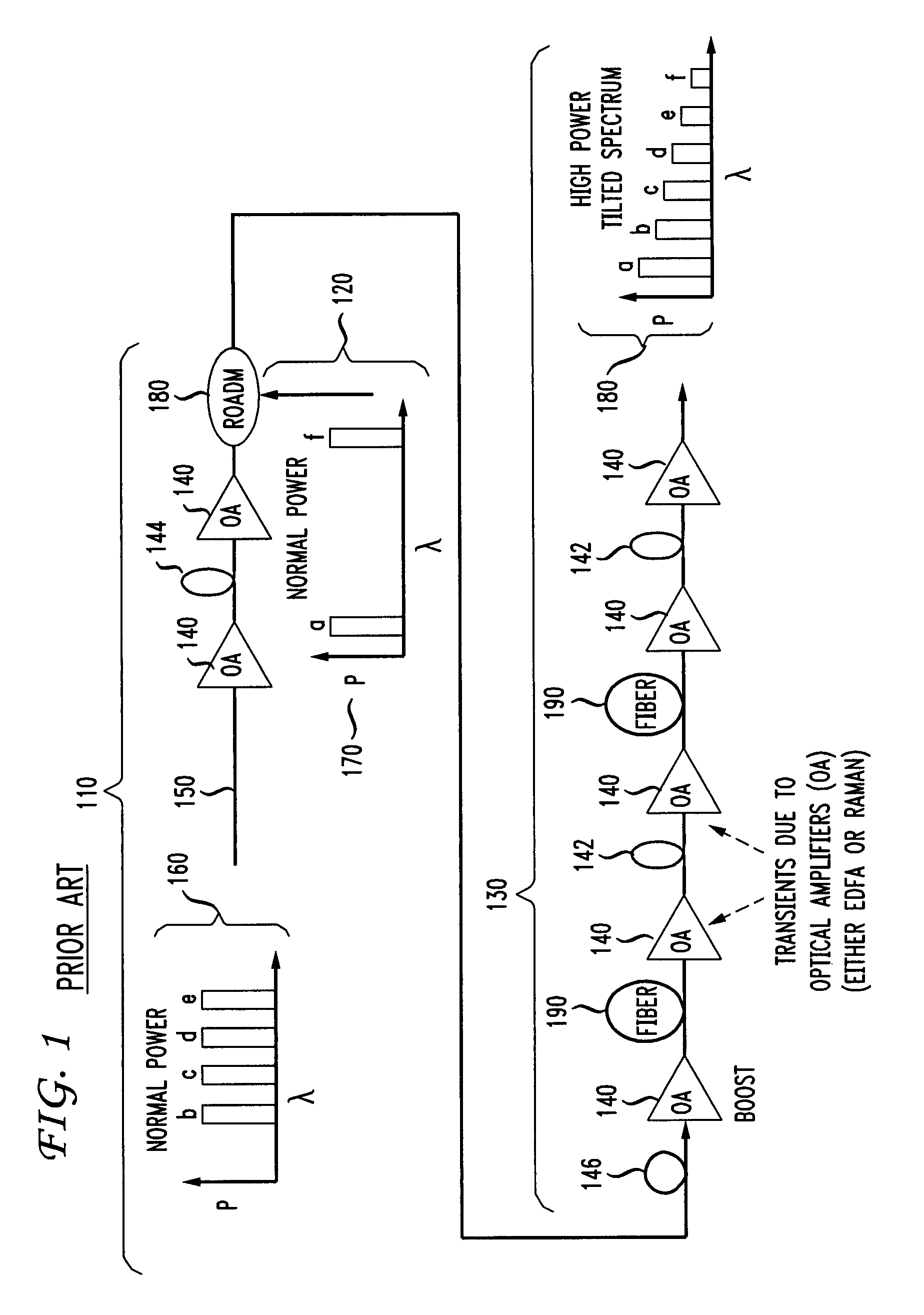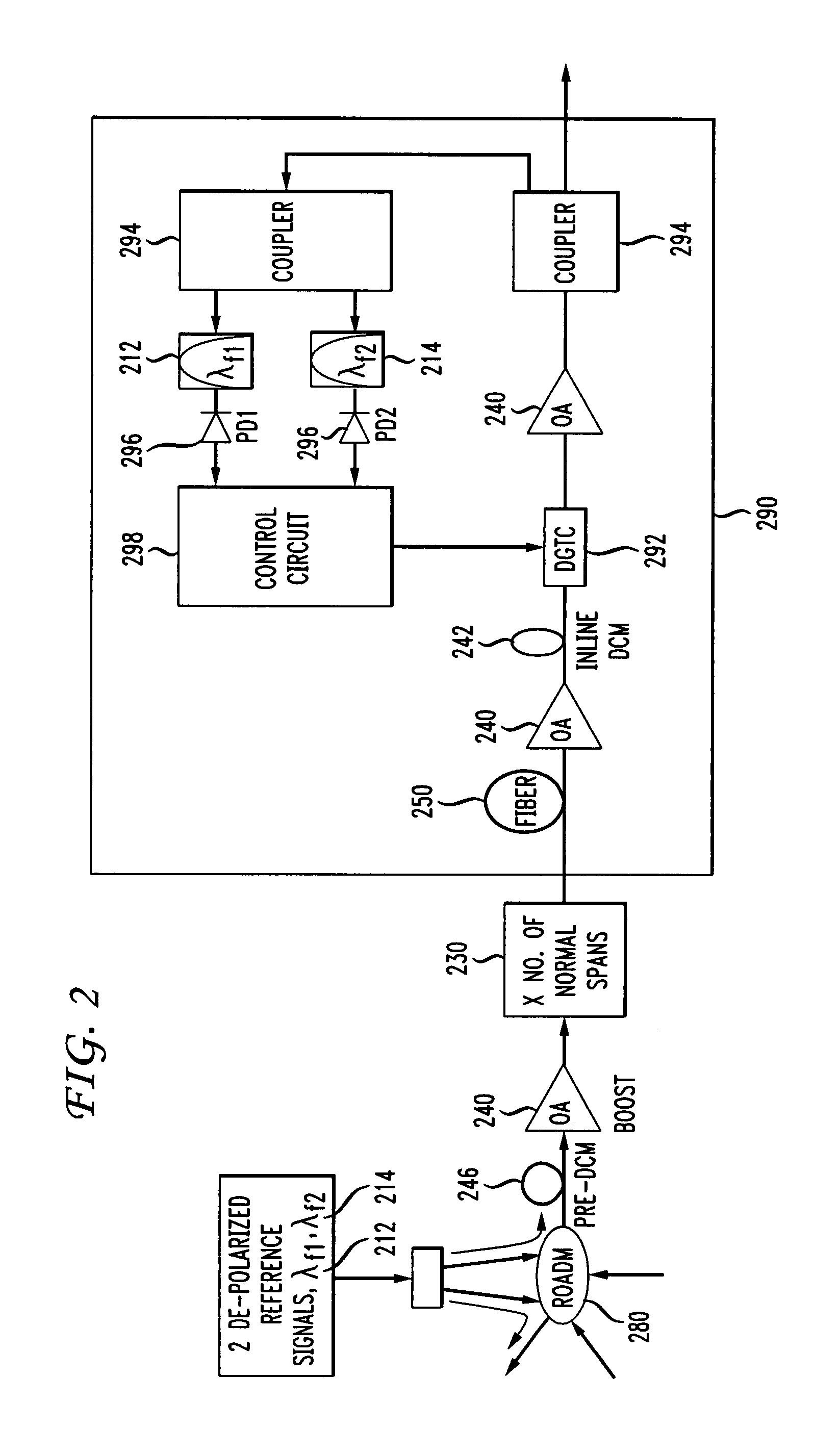Method and apparatus for adjusting for polarization-induced, optical signal transients
- Summary
- Abstract
- Description
- Claims
- Application Information
AI Technical Summary
Benefits of technology
Problems solved by technology
Method used
Image
Examples
first embodiment
[0036]FIG. 2 shows the invention where two depolarized reference channels or signals 212 and 214 are used to eliminate the uncertainty caused by polarization effects. The reference signals 212 and 214 have different wavelengths and are added or multiplexed by means of a ROADM 180 into a fiber optic link containing a plurality of channels. The reference signals comprise at least one known characteristic which can be measured or estimated at two points on a fiber optic network, such as at the beginning and end of a fiber optic link. Alternatively, a polarization scrambler may be utilized which scrambles the states of polarization of the two reference signals 212 and 214. Reference numbers on FIG. 2 correspond to the reference numbers of FIG. 1. For example, reference signal 112 in FIG. 1 is reference signal 212 in FIG. 2. The reference signals 212 and 214 may be any depolarized light beam known in the art such as from a Distributed Feedback laser or a Fiber Bragg grating stabilized Fa...
second embodiment
[0043]FIG. 4a shows the invention where total optical power of all channels is measured in addition to the power of the reference channels. The total optical power is the sum of the power transmitted in each channel propagating in the optical network. Reference numbers in FIG. 4a correspond to the reference numbers of FIG. 3. For example, reference signal 312 in FIG. 3 is reference signal 412 in FIG. 4a. As above, elements of FIG. 4a which correspond to elements in FIGS. 2 and 3 are given similar numbers. In this embodiment, a 1:2 coupler 494 sends the signals to be measured from the fiber optic cable 450 to the control circuit 498 by way of a 1:3 coupler 495 then separates the signal into the reference signal 412, reference signal 414, and entire transmitted signal. In this embodiment of the invention, the reference signals 412 and 414 are polarized.
[0044]FIG. 4b shows the total optical power in dBm as a function of gain difference in dB in the second embodiment. As optical power i...
third embodiment
[0048]FIG. 5 shows the invention where gain tilt is estimated from the total optical power. This measurement is used to adjust the tilt at the DGTC 592. This method proceeds by measuring total optical power transmitted in the optical link and the power in one reference signal 512. In this embodiment, the reference signal 512 may be polarized, depolarized, or scrambled. When the reference signal 512 is polarized, the amount of tilt can be estimated based on a comparison between the total optical power and optical power of the reference signal. For example, when the variation in the total optical power is relatively small and the measured relative power variation of the polarized reference signal is relatively large, it can be deduced that a polarization event has taken place which has affected the signal. This measurement can be used to compensate for the polarization effects.
PUM
 Login to View More
Login to View More Abstract
Description
Claims
Application Information
 Login to View More
Login to View More - R&D
- Intellectual Property
- Life Sciences
- Materials
- Tech Scout
- Unparalleled Data Quality
- Higher Quality Content
- 60% Fewer Hallucinations
Browse by: Latest US Patents, China's latest patents, Technical Efficacy Thesaurus, Application Domain, Technology Topic, Popular Technical Reports.
© 2025 PatSnap. All rights reserved.Legal|Privacy policy|Modern Slavery Act Transparency Statement|Sitemap|About US| Contact US: help@patsnap.com



